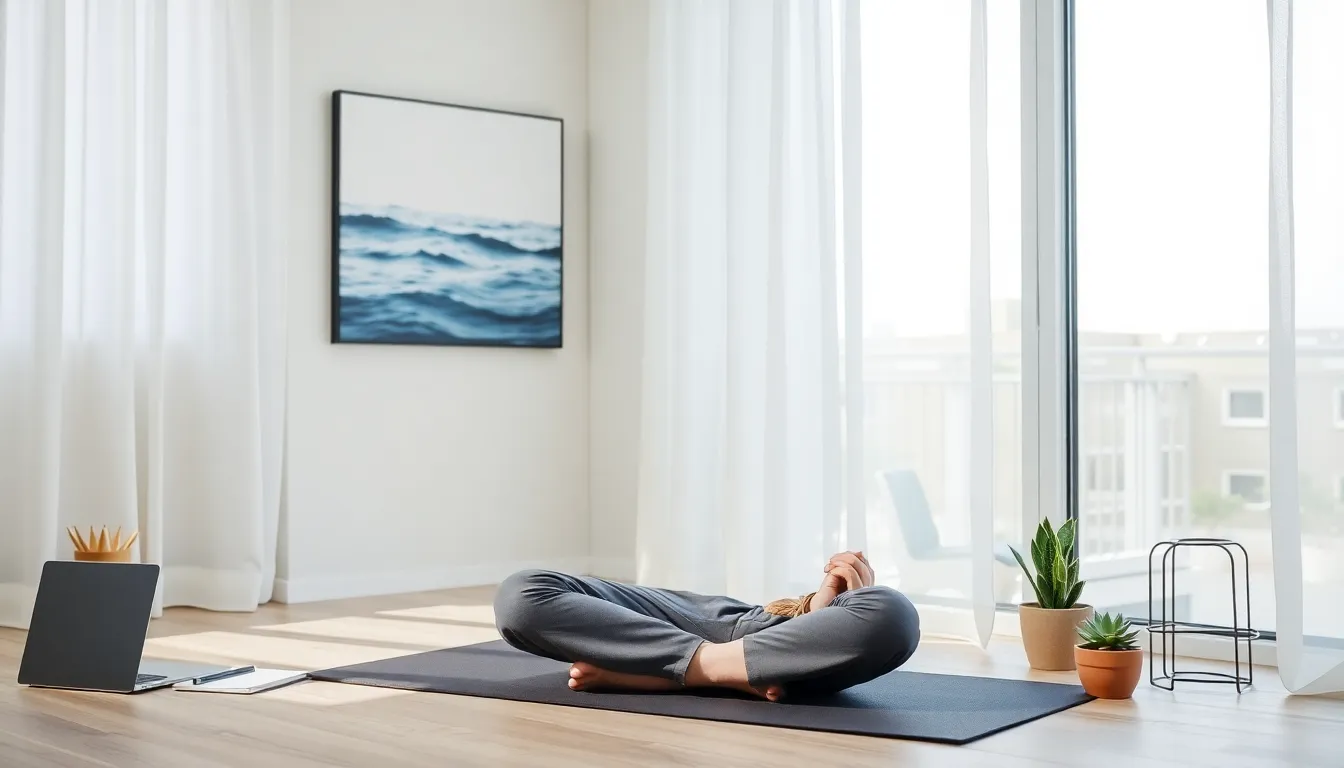Table of Contents
ToggleImagine a world where your wallet feels lighter and your clutter disappears faster than your last online shopping spree. The Buy-Nothing Challenge invites brave souls to embrace minimalism and redefine their relationship with consumerism. It’s not just a quirky trend; it’s a movement that encourages participants to resist the urge to splurge for an entire month.
Overview of the Buy-Nothing Challenge
The Buy-Nothing Challenge invites individuals to abstain from all purchases for a designated period, typically a month. Participants engage in self-reflection about their consumption habits during this time. Minimalism stands at the core of this movement, prompting people to streamline their lives by re-evaluating needs versus wants.
Benefits associated with the Buy-Nothing Challenge include significant reductions in both clutter and stress. Clutter often complicates living spaces, leading to frustration. Freeing oneself from the cycle of buying leads to enhanced mental clarity and emotional well-being. Moreover, this challenge fosters a deeper relationship with consumerism, pushing individuals to consider the impact of their spending on the environment and on their financial health.
Communities around the Buy-Nothing Challenge often arise, allowing participants to exchange goods without financial transactions. These groups facilitate sharing, fostering a sense of community and collaboration. Items can circulate among members, reducing waste and promoting sustainable practices.
Understanding the challenge’s roots can enhance engagement. The movement emphasizes mindful consumption and conscious living. Participants often discover the joys of life without the weight of consumer goods, leading to a renewed appreciation for experiences over material possessions.
By reframing spending habits, individuals unlock transformative personal growth. Challengers frequently report a sense of freedom from societal pressures surrounding consumerism. Embracing this lifestyle not only benefits participants but also promotes a broader cultural shift towards sustainability and minimalism.
Principles of the Buy-Nothing Challenge
The Buy-Nothing Challenge centers around a few core principles that guide participants towards mindful living.
Simplicity and Minimalism
Simplicity defines the heart of the Buy-Nothing Challenge. Participants focus on decluttering their lives by avoiding unnecessary purchases. Minimalism comes into play as individuals assess their needs versus wants. Taking time to reflect on belongings fosters a deeper understanding of what truly matters. Each choice to refrain from buying supports a lifestyle that values experiences over things. Ultimately, participants often feel lighter and more liberated as they embrace a simpler way of living.
Community Engagement
Community engagement plays a vital role in the Buy-Nothing Challenge. Many participants join local groups to foster connections and share resources. Exchange of goods often occurs without monetary transactions, emphasizing sustainable practices. Borrowing items from neighbors becomes common, reinforcing the spirit of sharing. Through this collaborative approach, individuals build a sense of belonging that strengthens community bonds. Creating a support network enhances the overall experience of the challenge while promoting a collective shift towards intentional living.
Benefits of Participating
The Buy-Nothing Challenge offers various benefits that enhance overall well-being and promote sustainable living.
Financial Savings
Participating in the challenge leads to significant financial savings. By refraining from purchases, individuals avoid impulse spending and unnecessary expenses. For instance, eliminating non-essential items can free up hundreds of dollars each month. Participants often redirect their budget toward essentials or experiences that truly matter. Saving money promotes a sense of financial security and encourages better budgeting practices. Over time, these habits can lead to increased savings and improved financial stability.
Environmental Impact
The challenge helps reduce environmental waste significantly. Avoiding new purchases lessens the demand for production, resulting in lower carbon footprints associated with manufacturing and shipping. Individuals become more mindful of their consumption habits, often opting for secondhand goods or exchanging items within their communities. This practice contributes to a circular economy, promoting reuse, and minimizing landfill contributions. Collectively, these small actions can foster a healthier planet, encouraging others to adopt environmentally friendly practices.
Mental Health Benefits
Enhanced mental clarity and emotional well-being often result from participating in the Buy-Nothing Challenge. Participants declutter their lives, leading to reduced stress and feelings of overwhelm. Moreover, individuals gain insight into their consumption habits, helping them distinguish needs from wants. This self-reflection fosters a sense of empowerment and purpose. Engaging with a community of like-minded individuals further supports mental health, providing social connections and encouragement. Through these positive changes, participants often experience greater life satisfaction and fulfillment.
Challenges Faced by Participants
Participants in the Buy-Nothing Challenge encounter several notable challenges throughout their journey. These experiences shape their understanding of consumerism and personal habits.
Social Pressure
Social pressure often emerges as a significant challenge for those participating in the Buy-Nothing Challenge. Friends and family may question their decision to refrain from purchases, leading to feelings of isolation. Joining the challenge can also feel daunting in a consumer-driven society that values spending and accumulation. During gatherings, participants might face temptation to indulge in retail therapy, which complicates their commitment. Navigating these situations requires resilience and strong motivation to adhere to their goals. Many find it beneficial to communicate their reasons for participating, fostering understanding and support within their social circles.
Adjusting Habits
Adjusting habits is another critical hurdle participants confront. Transitioning from a consumption-focused lifestyle to one that emphasizes mindfulness can be challenging. Individuals often rely on shopping as a source of entertainment or stress relief. Breaking this connection demands intentionality and self-reflection. Developing new routines helps participants discover alternative ways to cope with emotions or boredom, such as engaging in hobbies or spending time outdoors. Support from local groups is essential, providing encouragement and sharing strategies for overcoming tempting situations. Embracing this transformation enables participants to appreciate a simpler, more meaningful life beyond material possessions.
Tips for Success in the Buy-Nothing Challenge
Success in the Buy-Nothing Challenge requires intention and commitment. Participants achieve lasting results by adopting effective strategies.
Setting Clear Goals
Start by defining specific objectives for the challenge. For instance, aim for zero purchases or eliminate spending on non-essential items. Identifying personal motivations can enhance focus. Some may want to reduce clutter or save money, while others seek mindfulness in consumption. Regularly reviewing these goals keeps participants accountable and motivated throughout the month. Breaking down larger goals into smaller milestones helps maintain momentum and boosts confidence in achieving targets.
Finding Community Support
Connecting with others strengthens resolve and enriches the experience. Local Buy-Nothing groups or online communities provide invaluable support and resources. Participants share tips and strategies, facilitating collaboration and encouragement. Engaging with like-minded individuals fosters a sense of belonging, reducing feelings of isolation. Regularly participating in group activities amplifies the challenge’s benefits, such as exchanging goods or organizing shared events. Building these connections enhances the overall experience and reinforces the importance of mindful consumption.
Embracing the Buy-Nothing Challenge can lead to profound personal and communal transformations. Participants often discover a newfound appreciation for simplicity and mindfulness. By focusing on experiences rather than material possessions, they cultivate deeper connections with themselves and their communities.
The challenge encourages individuals to reflect on their consumption habits, promoting a healthier relationship with money and the environment. Through shared experiences and support, participants not only reduce clutter but also foster a sense of belonging.
Ultimately, the Buy-Nothing Challenge serves as a powerful reminder that true fulfillment often comes from within, not from the latest purchase. As more people join this movement, it paves the way for a more sustainable and intentional way of living.







